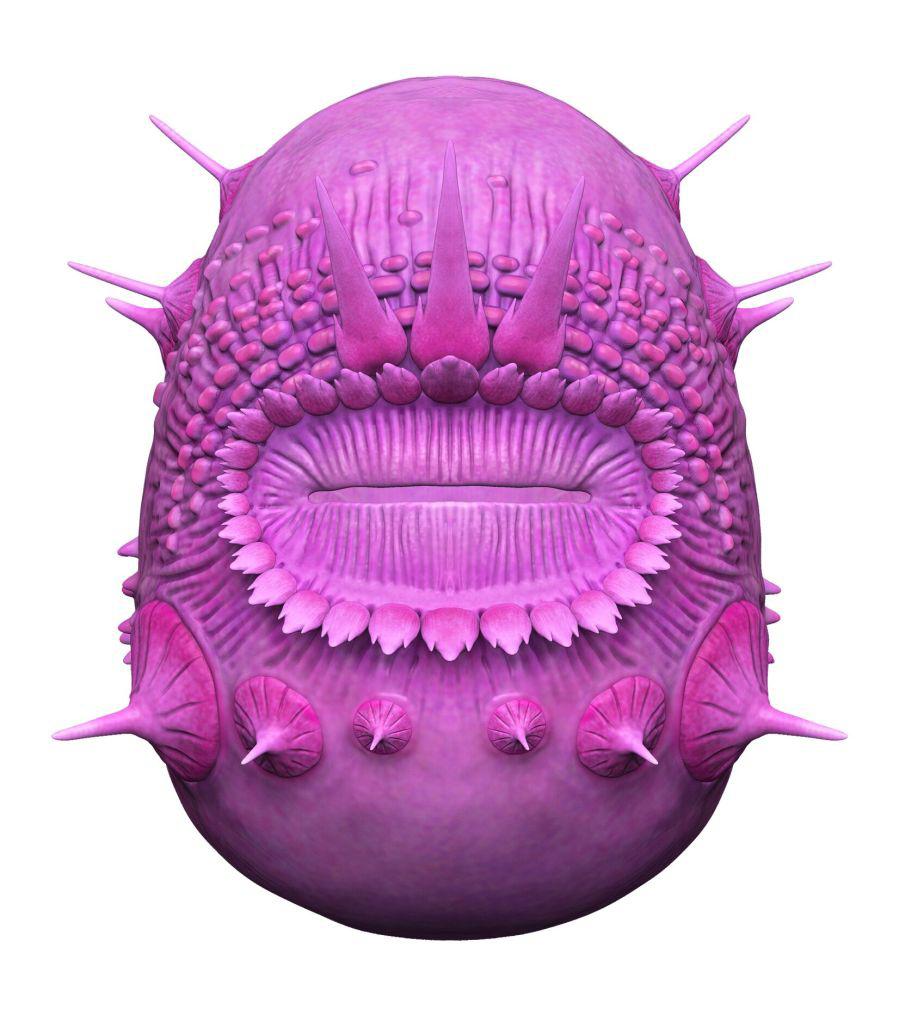Science 3D-Models Show That 540-Million-Year Old Bag-Like Creature Is Not Earliest Human Ancestor David Bressan Contributor Opinions expressed by Forbes Contributors are their own. I deal with the rocky road to our modern understanding of earth New! Follow this author to stay notified about their latest stories. Got it! Aug 17, 2022, 04:29pm EDT | New! Click on the conversation bubble to join the conversation Got it! Share to Facebook Share to Twitter Share to Linkedin Life-like reconstruction of Saccorhytus.
Donoghue/Nature In 2017, Chineses scientists announced the discovery of the 540-million-year-old Saccorhytus fossil , believed to be the earliest known deuterostome, a group including today seastars, vertebrate animals and humans. Even if Saccorhytus doesn’t reseamble any modern animal, looking more like a spikey, wrinkly sack, a series of holes surrounding the large mouth were interpreted as pores for gills—a primitive feature of the deuterostome group. However, an extensive analysis of the remains has shown that the holes around the mouth are bases of spines that broke away during the preservation of the fossil.
According to author Yunhuan Liu, professor in Paleobiology at Chang’an University, “S accorhytus was a curious beast, with a mouth but no anus, and rings of complex spines around its mouth. ” Researcher Emily Carlisle from the University of Bristol’s School of Earth Sciences explained: ” Fossils can be quite difficult to interpret and Saccorhytus is no exception. We had to use a synchrotron, a type of particle accelerator, as the basis for our analysis of the fossils.
The synchrotron provides very intense X-Rays that can be used to take detailed images of the fossils. We took hundreds of X-Ray images at slightly different angles and used a supercomputer to create a 3D digital model of the fossils, which reveals the tiny features of its internal and external structures. ” The digital models showed that pores around the mouth were closed by another body layer extending through, creating spines around the mouth.
“We believe these would have helped Saccorhytus capture and process its prey,” suggests Huaqiao Zhang from the Nanjing Institute of Geology and Paleontology. MORE FOR YOU New Research Finds A Connection Between Domestic Violence And These Two Personality Disorders This Scientist Helps Andean Forests And Ecuador’s Women In STEM Exceptional Fossil Preservation Suggests That Discovering Dinosaur DNA May Not Be Impossible The researchers believe that Saccorhytus is in fact an ecdysozoan: a group that contains arthropods and nematodes. “We considered lots of alternative groups that Saccorhytus might be related to, including the corals, anemones and jellyfish which also have a mouth but no anus,” said Prof Philip Donoghue of University of Bristol’s School of Earth Sciences, who co-led the study.
“To resolve the problem our computational analysis compared the anatomy of Saccorhytus with all other living groups of animals, concluding a relationship with the arthropods and their kin, the group to which insects, crabs and roundworms belong. ” Saccorhytus ‘ lack of anus is an intriguing feature of this microscopic, ancient organism. Although the question that springs to mind is the alternative route of digestive waste (out of the mouth, rather undesirably), this feature is important for a fundamental reason of evolutionary biology.
How the anus arose—and sometimes subsequently disappeared—contributes to the understanding of how animal bodyplans evolved. Moving Saccorhytus from deuterosome to ecdysozoan means striking a disappearing anus off the deuterosome case history, and adding it to the ecdysozoan one. “This is a really unexpected result because the arthropod group have a through-gut, extending from mouth to anus.
Saccorhytus ‘s membership of the group indicates that it has regressed in evolutionary terms, dispensing with the anus its ancestors would have inherited,” says Shuhai Xiao from Virgina Tech, U. S. , who co-led the study.
“We still don’t know the precise position of Saccorhytus within the tree of life, but it may reflect the ancestral condition from which all members of this diverse group evolved. ” The paper ” Saccorhytus is an early ecdysozoan and not the earliest deuterostome ” is published in Nature (2022). Materials provided by University of Bristol .
David Bressan Editorial Standards Print Reprints & Permissions.
From: forbes
URL: https://www.forbes.com/sites/davidbressan/2022/08/17/3d-models-show-that-540-million-year-old-bag-like-creature-is-not-earliest-human-ancestor/



